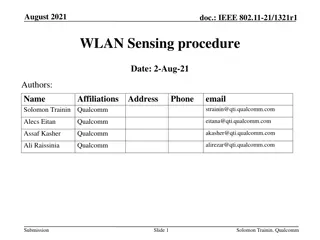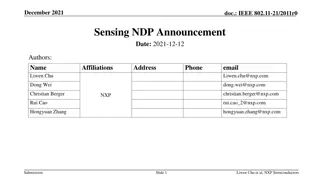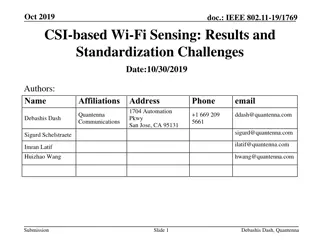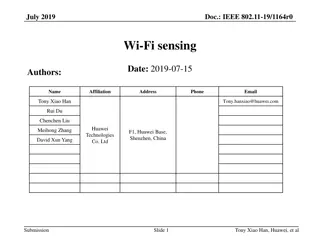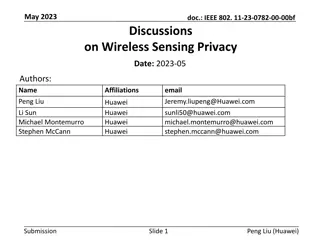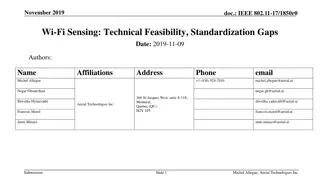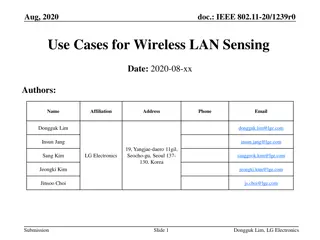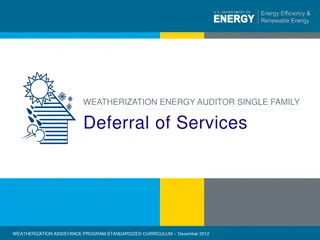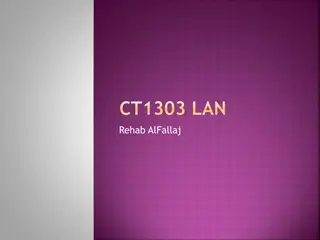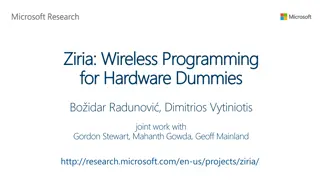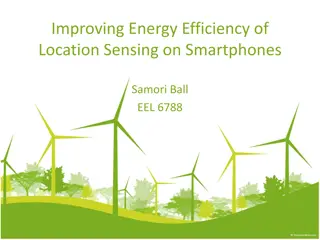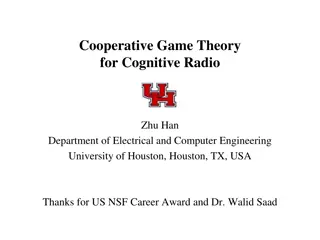Spectrum Sensing-Based Deferral Enhancement for Wireless Networks
Simulation evaluation and enhancement proposal for Spectrum Sensing-Based Deferral (SSBD) channel access to improve latency and performance in hidden node scenarios. The proposed solution includes interference mitigation, coexistence improvements, backward compatibility, reduced air-time, improved link budget, additional channels, and enhanced reliability.
Download Presentation

Please find below an Image/Link to download the presentation.
The content on the website is provided AS IS for your information and personal use only. It may not be sold, licensed, or shared on other websites without obtaining consent from the author. Download presentation by click this link. If you encounter any issues during the download, it is possible that the publisher has removed the file from their server.
E N D
Presentation Transcript
November 2022 doc. #: IEEE 802.15-22-0606-00-04ab Project: IEEE P802.15 Working Group for Wireless Specialty Networks (WSN) Submission Title: Spectrum Sensing Based Deferral Evaluation and Enhancement Submitted: November 12, 2022 Source: Peng Liu, Ziyang Guo (Huawei Technologies) E-Mail: Jeremy.liupeng@huawei.com Abstract: Simulation evaluation on Spectrum Sensing Based Deferral (SSBD) channel access and propose an enhancement idea in hidden node scenario. Purpose: enhanced channel access to reduce latency and perform better performance in hidden node scenarios Notice: This document has been prepared to assist the IEEE 802. It is offered as a basis for discussion and is not binding on the contributing individual(s) or organization(s). The material in this document is subject to change in form and content after further study. The contributor(s) reserve(s) the right to add, amend or withdraw material contained herein. Release: The contributor acknowledges and accepts that this contribution becomes the property of IEEE and may be made publicly available by 802.15. Peng Liu (Huawei)
November 2022 doc. #: IEEE 802.15-22-0606-00-04ab PAR Objective Proposed Solution (how addressed) Safeguards so that the high throughput data use cases will not cause significant disruption to low duty-cycle ranging use cases SSBD uses channel sensing (CCA) and time bounded deferral to reduce collision, enhanced in hidden node scenario, by enlarging contention window when collisions happen enlarging contention window when collisions happen Interference mitigation techniques to support higher density and higher traffic use cases Other coexistence improvement Can improve coexistence in the presence of UWB and non- UWB spectrum users. Has no impact on backward compatibility. It is an optional feature in 4ab capable devices. reduce air-time by reducing collisions Backward compatibility with enhanced ranging capable devices (ERDEVs) Improved link budget and/or reduced air-time Additional channels and operating frequencies Improvements to accuracy / precision / reliability and interoperability for high-integrity ranging Reduced complexity and power consumption Hybrid operation with narrowband signaling to assist UWB Reliability can be enhanced by deferral transmission Enhanced native discovery and connection setup mechanisms Sensing capabilities to support presence detection and environment mapping Low-power low-latency streaming Reducing latency via linear backoff and reducing collisions Higher data-rate streaming allowing at least 50 Mbit/s of throughput Support for peer-to-peer, peer-to-multi-peer, and station-to- infrastructure protocols Infrastructure synchronization mechanisms Slide 2 Peng Liu (Huawei)
November 2022 doc. #: IEEE 802.15-22-0606-00-04ab SSBD Algorithm Review and Evaluation Bounded channel access latency: -- Linear back-off -- optionally, revert to Aloha on failure 2?? 1 for CSMA In this submission, we evaluate SSBD by simulation, in terms of -- Linear backoff (LB) vs Binary exponential backoff (BEB) -- With Aloha or Without Aloha Evaluation Metrics -- Mean Latency and Jitter (Standard Deviation of Latency) -- Mean Throughput (0~100%) Not transmit for without Aloha SSBD Algorithm [1] Peng Liu (Huawei)
November 2022 doc. #: IEEE 802.15-22-0606-00-04ab Mean Latency Light Traffic Load Medium Traffic Load High Traffic Load 0.0025 0.011 LB, No Aloha BEB, No Aloha 0.0033 0.0024 LB, Aloha BEB, Aloha 0.0031 0.01 0.0023 0.0029 Mean Latency (s) Mean Latency (s) Mean Latency (s) 0.009 0.0022 0.0027 0.0021 0.008 0.0025 0.002 0.007 0.0023 0.0019 0.006 0.0021 0.0018 0.0019 0.005 0.0017 LB, No Aloha BEB, No Aloha 0.0017 LB, No Aloha LB, Aloha BEB, No Aloha BEB, Aloha 0.004 0.0016 LB, Aloha BEB, Aloha 0.0015 0.0015 0.003 2 3 4 5 6 7 8 9 10 2 3 4 5 6 7 8 9 10 2 3 4 5 6 7 8 9 10 Number of Contending Links Number of Contending Links Number of Contending Links Simulation settings: -- Traffic load: 1 ??= traffic load, 20% light, 40% medium, 80% high ? ? ?=1 -- data rate = 6.8Mbps, packet length = 1500Bytes, macMinBf = 1, macMaxBf =1024 -- NB is set as the cut-off waiting delay = 10ms For mean latency, LB is lower than BEB, with Aloha without Aloha Peng Liu (Huawei) Slide 4
November 2022 doc. #: IEEE 802.15-22-0606-00-04ab Jitter Light Traffic Load Medium Traffic Load High Traffic Load 0.0035 0.012 0.0016 0.0014 0.003 0.01 0.0012 0.0025 0.008 0.001 Jitter(s) Jitter(s) Jitter(s) 0.002 0.006 0.0008 0.0015 0.0006 0.004 0.001 0.0004 0.002 0.0005 LB, No Aloha LB, Aloha BEB, No Aloha BEB, Aloha LB, No Aloha LB, Aloha BEB, No Aloha BEB, Aloha 0.0002 LB, No Aloha BEB, No Aloha LB, Aloha BEB, Aloha 0 0 0 2 3 4 5 6 7 8 9 10 2 3 4 5 6 7 8 9 10 2 3 4 5 6 7 8 9 10 Number of Contending Links Number of Contending Links Number of Contending Links For Jitter, LB is lower than BEB, with Aloha without Aloha Peng Liu (Huawei) Slide 5
November 2022 doc. #: IEEE 802.15-22-0606-00-04ab Mean Throughput Light Traffic Load Medium Traffic Load High Traffic Load 0.4 0.8 0.5 LB, No Aloha BEB, No Aloha 0.45 0.35 0.75 LB, Aloha BEB, Aloha 0.4 Mean Throughput Mean Throughput Mean Throughput 0.3 0.7 0.35 0.25 0.3 0.65 0.25 0.2 0.6 0.2 LB, No Aloha LB, Aloha BEB, No Aloha BEB, Aloha 0.15 0.55 LB, No Aloha BEB, No Aloha 0.15 LB, Aloha BEB, Aloha 0.1 0.1 0.5 2 3 4 5 6 7 8 9 10 2 3 4 5 6 7 8 9 10 2 3 4 5 6 7 8 9 10 Number of Contending Links Number of Contending Links Number of Contending Links For throughput, LB BEB, with Aloha without Aloha at light traffic load and medium traffic load scenarios, with Aloha is lower than without Aloha at high traffic load scenario Peng Liu (Huawei) Slide 6
November 2022 doc. #: IEEE 802.15-22-0606-00-04ab Summary of Evaluation Linear backoff is able to reduce mean latency and jitter compared with binary exponential backoff, which is aligned to the simulation results in [2]. When the network traffic load is high, using Aloha might reduce throughput in non-cooperated homogeneous cases because the number of collisions increases In practice, how to use Aloha option may need to further evaluation. Peng Liu (Huawei) Slide 7
November 2022 doc. #: IEEE 802.15-22-0606-00-04ab SSBD Enhancement (1) SSBD cannot work well in hidden terminal cases. The reason is that random backoff (Deferral) is only associated with CCA. If CCA is not aware of spectrum usage, it can result in a large number of collisions and very low throughput Link #1 Link #2 Peng Liu (Huawei) Slide 8
November 2022 doc. #: IEEE 802.15-22-0606-00-04ab SSBD Enhancement (2) SSBD can be enhanced by introducing a conflict resolution mechanism, which expands the backoff window after a packet fails to be transmitted (no ACK is received). SSBD+ Peng Liu (Huawei) Slide 9
November 2022 doc. #: IEEE 802.15-22-0606-00-04ab Summary Linear Backoff is a very good idea to reduce latency (both mean latency and jitter) In practice, when/how to use Aloha option may need to further discussion. SSBD+: Enlarge Backoff window after unsuccessful packet transmission to further resolve collisions in hidden terminal scenarios Peng Liu (Huawei) Slide 10
November 2022 doc. #: IEEE 802.15-22-0606-00-04ab Reference 1. 15-22-0485-01-04ab-Spectrum Sensing Based Deferral 2. 15-22-0558-02-04ab-ssbd-latency-analysis Peng Liu (Huawei) Slide 11













